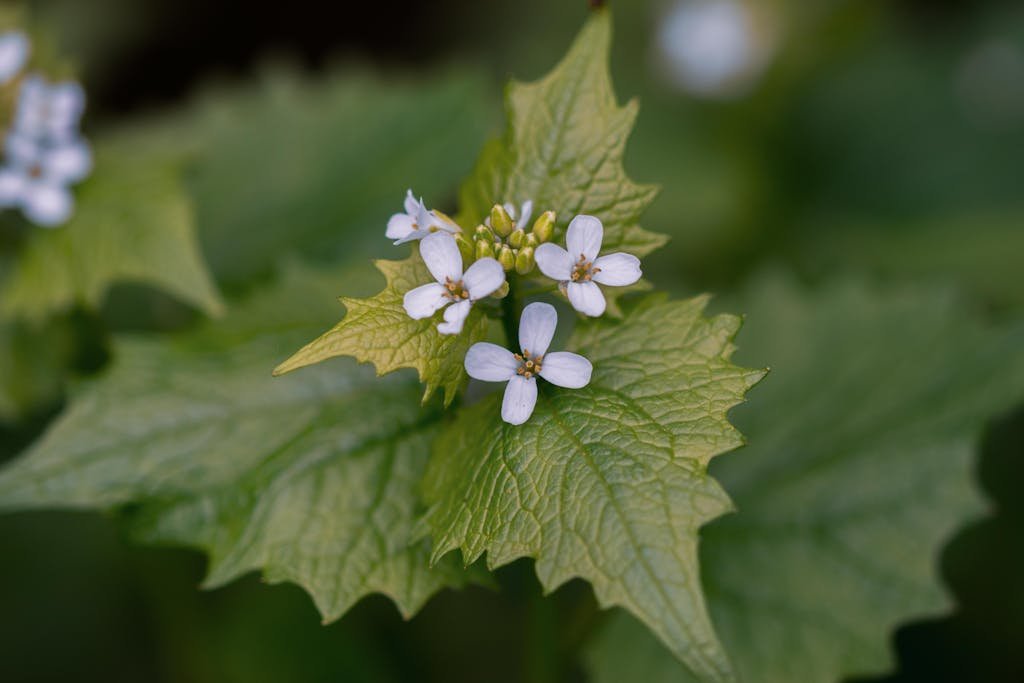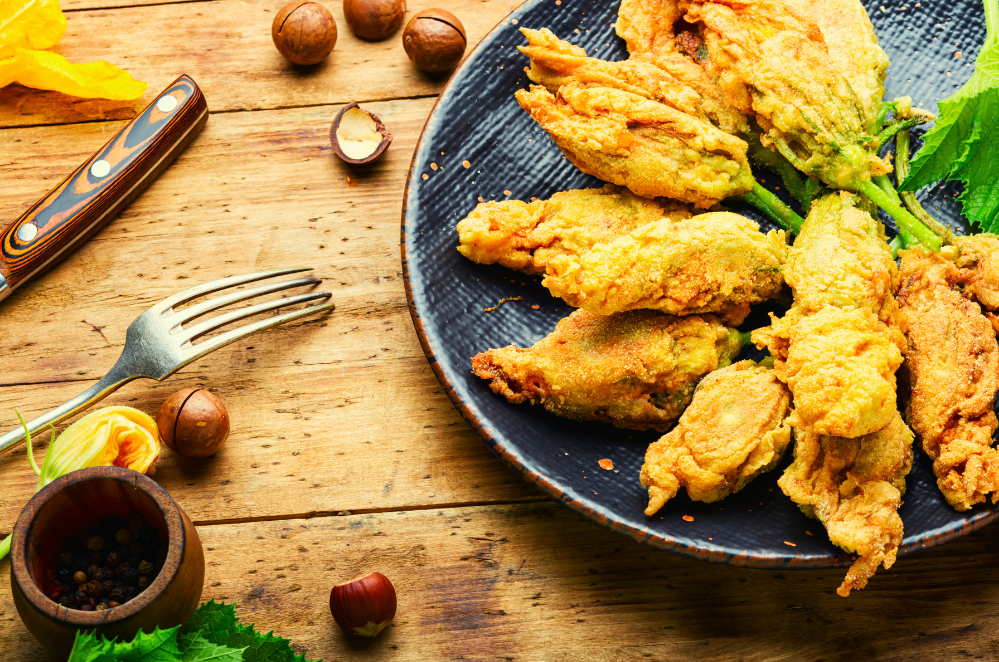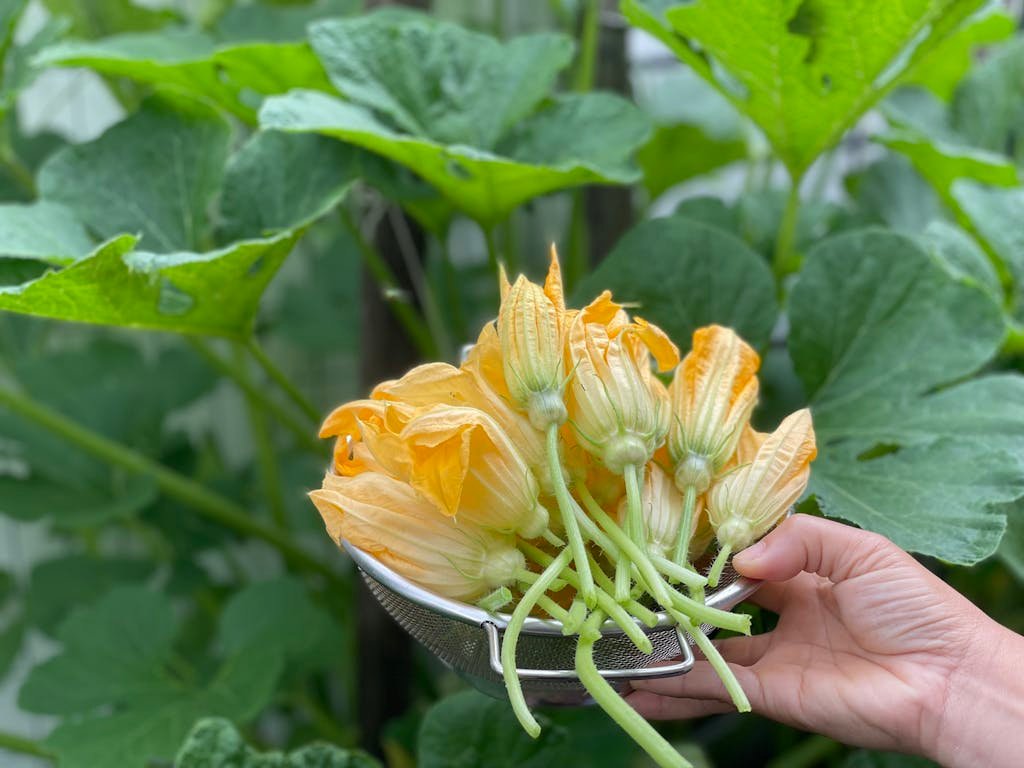


If you’ve never tried a stuffed courgette flowers recipe before, you’re in for a real treat! These bright, delicate blossoms might look fancy, but they’re actually easy to fill with fresh goodness from your garden and hedgerow. And the best part? They bring a little magic of spring or early summer straight to your plate.
In our small garden, courgette plants always seem to surprise us with their sunny flowers. They pop open almost overnight, like little golden stars waiting to be picked. But instead of just admiring them, we love to turn them into something truly tasty. When we stuff these blossoms with a mix of foraged greens, like Jack-by-the-Hedge and ground elder, they become a dish that’s full of flavor and goodness.
What makes this recipe so special is that it’s not just about cooking — it’s about stepping outside, picking what nature offers, and bringing it to your kitchen. Plus, it’s a fun way to get more vitamins and nutrients into your meals without much effort. The filling is fresh, light, and full of those wild, green flavors that remind you it’s a new season.
So grab a basket, head out to the garden or hedgerow, and let’s make something simple yet wonderful. With just a few easy steps, you can create a dish that looks beautiful, tastes amazing, and feels like a little celebration of nature.
How to Grow Courgettes: A Gardener’s Overview
Growing courgettes is one of the most rewarding things you can do in your garden. These plants are quick to grow, easy to care for, and give you loads of tasty fruit and lovely golden flowers. But here’s the magic — those bright, cheerful blooms aren’t just pretty to look at. Courgette flowers are a perfect edible canvas! Their soft petals are just right for stuffing, frying, or adding to salads. Because the flavour is so gentle, they carry other tastes beautifully, from creamy cheeses to fresh garden herbs. So, as you grow courgettes, you’re not only filling your patch with food — you’re growing something that lets your creativity shine in the kitchen too.
Let’s take a look at what you need to know to get started!
Ideal Conditions: Soil Type, Sunlight, and Space
Courgettes love rich, well-drained soil. It helps if the ground is full of compost or well-rotted manure. Choose a sunny spot, because these plants need warmth to thrive. And don’t forget—they like room to spread out, so give each one plenty of space!
When and How to Sow Courgette Seeds
You can start seeds indoors in small pots during spring, about 4-6 weeks before the last frost. Or, once the weather warms up, sow them directly into the soil outside. Either way, keep the soil moist until the seedlings pop up.
Care Tips: Watering, Feeding, and Supporting Growth
Courgettes get thirsty, especially when they start making fruit. Water them well and feed with a liquid plant food now and then. If the plants sprawl too much, you can gently support them with canes or string.
Encouraging Lots of Flowers
You’ll see both male and female flowers on your plants. To get lots of fruit, try hand-pollinating or planting more than one courgette to help the bees do their job.
Harvesting Tips for Flowers
Pick flowers in the morning when they’re fresh and wide open. It’s easy to spot the difference between male and female flowers once you know what to look for. Male flowers grow on long, thin stems and have a simple, straight middle part (the stamen) inside. Female flowers are easy to spot because they have a tiny baby courgette (or swelling) right behind the petals—this is what turns into fruit! If you want courgettes to grow, try not to pick too many female flowers.
Popular and Easy-to-Grow Varieties
Black Beauty – A classic dark-green courgette that grows quickly and produces lots of fruit. It’s been a favourite for years because it’s so dependable.
Defender – This green courgette is known for being resistant to diseases, so it’s a top pick for new gardeners. It’s reliable and gives a big harvest.
Gold Rush – A bright yellow courgette that looks beautiful on the plant and on your plate! It’s sweet and tender, and easy to spot among the leaves.
How to Identify Jack-by-the-Hedge (Garlic Mustard)
Jack-by-the-Hedge, also called Garlic Mustard, is a wild green that’s easy to spot once you know its secrets. First, look for its leaves. These are heart-shaped or softly triangular, with little jagged edges, and they’re bright green and soft to the touch. Next, try crushing a leaf gently between your fingers — you’ll notice a light garlic smell. That’s where it gets its name!
Then, in spring and early summer, watch for its flowers. You’ll see small white blooms with four petals shaped like a cross, gathered in tiny clusters at the top of the stems. Usually, you’ll find this plant growing along hedgerows, shaded paths, or woodland edges, where it enjoys dappled light and moist soil. So, keep your eyes peeled during your walks — it may be right under your nose!
Nutritional and Medicinal Benefits of Jack-by-the-Hedge
Jack-by-the-Hedge isn’t just tasty — it’s good for you too! For starters, it’s packed with vitamin C, beta-carotene, and useful minerals that help give your body a natural boost. On top of that, its mild garlic-mustard flavour is perfect for adding to courgette flower stuffing or tossing into fresh salads.
What’s more, this plant has a long history in folk medicine. In the past, people believed it could help with digestion, support immunity, and even offer antimicrobial properties. Today, we mostly enjoy it for its lovely flavour, but it’s nice to remember that Jack-by-the-Hedge has been treasured for generations.
How to Identify Ground Elder
Ground Elder is another wild green that’s easy to spot once you know what to look for. To begin with, check the leaves. They grow in groups of toothed leaflets — this means the edges of the leaves look like little teeth. In addition, look at where it likes to grow. You’ll often find Ground Elder in shady gardens, wild borders, or tucked into quiet corners where the soil is a bit damp.
For the best taste, it’s smart to pick the young, tender leaves. These are softer and have a nicer flavour. At the same time, be careful not to mix it up with plants that look similar but are toxic. If in doubt, always check with a plant guide or someone who knows their wild greens.
Nutritional and Medicinal Benefits of Ground Elder
Ground Elder isn’t just easy to find — it’s packed with goodness too! To start with, it’s rich in vitamin C, potassium, and other tiny nutrients your body loves. What’s more, it has been used for a long time as a natural remedy. People believed it could help with inflammation, and it was often used to ease gout.
On top of that, Ground Elder has a lovely flavour. The taste is mild, earthy, and just a little bit sweet — perfect for adding to courgette flower stuffing or tossing into a salad. So, all in all, next time you see it growing, you’ll know it’s not just a weed — it’s a tasty and useful plant with a long history!
The Recipe: Courgette Flowers Stuffed with Jack-by-the-Hedge, Ground Elder & Goat Cheese

Courgette Flowers Stuffed with Jack-by-the-Hedge & Ground Elder
Ingredients
- 8 courgette flowers
- 100 g Ricotta or Goats cheese
- 50 g fresh ground elder leaves finely chopped
- 50 g fresh Jack-by-the-hedge finely chopped
- 1 small garlic clove minced (optional)
- 1 tbsp Lemon juice
- 1 tsp Olive oil
- Salt and pepper to taste
Instructions
- Gently clean the courgette flowers. Remove the stamens inside without tearing the petals.
- Make the filling: In a bowl, mix the ricotta (or goat’s cheese), Jack-by-the-hedge, Ground Elder, garlic (if using), lemon juice, and 1 tsp olive oil. Season with salt and pepper.
- Carefully stuff the flowers: Use a teaspoon to fill each flower with the mixture. Twist the tips of the petals to seal.
- Optional: Lightly dust the outside of the flowers with flour for a delicate crust.
- Heat 50 ml olive oil in a non-stick pan over medium heat.
- Fry the stuffed flowers for about 2–3 minutes on each side until golden and heated through.
- Serve warm, with a drizzle of lemon juice or your favourite dip.
Notes
- Variations: Add a sprinkle of parmesan or crushed toasted nuts to the filling for extra flavour.
- Dips: Lovely with a yoghurt and mint dip, garlic aioli, or a simple squeeze of lemon.
- Storage: Best eaten fresh, but you can refrigerate cooked flowers for up to 1 day. Reheat gently in a pan.
- Gluten-free tip: Skip the flour dusting or use a gluten-free flour blend.
Conclusion
So there you have it — a wonderful way to turn your garden and hedgerow finds into something truly special! Courgette flowers really are like a blank canvas, ready to soak up the fresh flavours of early summer. With a little care, you can grow your own flowers, stuff them with tasty wild greens like Jack-by-the-hedge and Ground Elder, and enjoy a dish that feels fancy but is actually so simple to make.
Remember, it’s not just about the taste (though that’s reason enough!). When you use these wild and homegrown goodies, you’re adding a boost of vitamins and minerals to your meal. Plus, you get the joy of knowing exactly where your food comes from — right from your own patch of earth or the hedgerow down the lane.
Why not give it a try this week? Head out on a sunny morning, basket in hand, and see what you can find. Just be sure to harvest responsibly and safely.
If you’re looking for even more seasonal inspiration, don’t miss our June recipe page — it’s full of fresh, easy ideas that will help you make the most of what’s growing right now. From sweet treats to savoury dishes, there’s something for every home cook.
So go on, roll up your sleeves, get foraging, and bring a little taste of the wild into your kitchen today!
